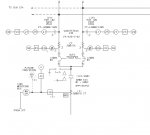enterprisenx
Member
Hello,
It was recently discovered that some years ago, a modification was made to several switchgear that involved the installation of a diode in a tripping circuit to essentially bypass the 86 relay to trip the circuit breakers. However, the 86 relay was still needed to be reset to re-energize the system. I can't figure out why this was done other than assuming the engineer at the time had issues with the mechanical 86 relay that was being used and decided to ensure both feeder breakers tripped by adding this additional wiring. All relays in the switchgear are electro-mechanical.
Has anyone seen this done before? Does it make sense to leave it in or does it create problems?
Please see attached. We have two 12kV feeder breakers (separate feeders) that supply a 12kV/480V transformer & 480V switchgear. There is only 1 - 86 LO relay. Perhaps there should have been 2 LO Relays. Anyway, just wanted to get peoples' perspectives on this installation as I have not seen diodes used to bypass or otherwise circumvent control functions.
Thanks,
Brian

It was recently discovered that some years ago, a modification was made to several switchgear that involved the installation of a diode in a tripping circuit to essentially bypass the 86 relay to trip the circuit breakers. However, the 86 relay was still needed to be reset to re-energize the system. I can't figure out why this was done other than assuming the engineer at the time had issues with the mechanical 86 relay that was being used and decided to ensure both feeder breakers tripped by adding this additional wiring. All relays in the switchgear are electro-mechanical.
Has anyone seen this done before? Does it make sense to leave it in or does it create problems?
Please see attached. We have two 12kV feeder breakers (separate feeders) that supply a 12kV/480V transformer & 480V switchgear. There is only 1 - 86 LO relay. Perhaps there should have been 2 LO Relays. Anyway, just wanted to get peoples' perspectives on this installation as I have not seen diodes used to bypass or otherwise circumvent control functions.
Thanks,
Brian


